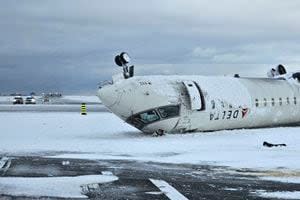A Delta Connection flight carrying 80 passengers and crew flipped upside down after skidding off an icy runway during a severe snowstorm at Toronto Pearson International Airport on February 17, 2025. While all aboard survived the dramatic crash, at least 18 people suffered injuries ranging from cuts to fractures. Thus, marking another in a series of recent weather-related aviation incidents that have sparked concerns about safety protocols in extreme conditions.
The Bombardier CRJ900LR, operated by Endeavor Air, was arriving from Minneapolis when it encountered near-whiteout conditions, with wind gusts exceeding 50 mph. Airport surveillance footage captured the harrowing moment as the aircraft slid and inverted on what one air traffic controller described as a runway “like an ice rink.”
“We were thrown against the windows, then everything went silent except the alarms,” recalled Marcus Greene, a Minneapolis businessman who was aboard the flight. Flight attendants quickly orchestrated evacuations through emergency exits, their efforts aided by the aircraft’s reinforced structure, which withstood the violent rollover.
Emergency response teams at Toronto Pearson reached the scene within minutes, extinguishing a small fire and treating passengers for injuries including head lacerations, sprains, and hypothermia. The airport suspended operations for more than three hours following the incident. In response, Delta Air Lines announced $30,000 in unconditional compensation for each passenger, a move one aviation attorney characterized as “unusually proactive” but not unprecedented.
The Transportation Safety Board of Canada (TSB), working alongside U.S. agencies, has begun analyzing cockpit voice recordings and flight data. Initial findings suggest multiple factors contributed to the crash. The pilots, who had received warnings about degraded braking conditions, may have overly relied on reverse thrust. A technique that can compromise directional control on icy surfaces.
“This wasn’t a single error but a perfect storm of factors,” explained TSB lead investigator Clara Nguyen. The investigation has revealed that the aircraft’s braking systems, though designed for typical winter operations, likely struggled with the rapid snow accumulation. The severe storm had left airport crews racing to clear runways, while ice reduced tire traction and strong crosswinds pushed the aircraft sideways during touchdown.
The Toronto incident follows several other weather-related aviation emergencies this winter. Three weeks prior, a commuter plane crash during an Alaskan blizzard claimed ten lives, while a medical transport jet in Philadelphia crashed in freezing fog, killing six. Additionally, an American Airlines flight barely avoided disaster near Washington after colliding with a military helicopter in low visibility.
These incidents have exposed potential gaps in current aviation safety measures. “Pilots train for icy runways, but not for the compounding risks we are seeing now, super storms, rapid temperature swings,” said John Keller, a former NTSB investigator. The Federal Aviation Administration faces mounting pressure to update guidelines for contaminated runway operations, particularly after a 2023 incident where a Southwest Airlines jet overshot a snowy taxiway in Denver.
The aviation industry now confronts the challenge of addressing immediate safety concerns while rebuilding public confidence. Delta has committed to reviewing winter training procedures for its regional partners, while the FAA explores requiring real-time friction sensors on runways. A technology already tested in Europe but not widely implemented in North America. Simultaneously, the National Transportation Safety Board is conducting an audit of older aircraft maintenance records following the Philadelphia crash’s connection to a faulty de-icing system.
For survivors, the incident has left lasting impressions. “I kept thinking, ‘This only happens in movies,'” said passenger Emily Torres, who sustained a sprained wrist. “Now, I’ll always check the weather before flying.” Her sentiment reflects a growing anxiety among recent incident survivors, despite aviation’s overall strong safety record.
As investigators continue their work, the damaged Bombardier remains in a hangar at Toronto Pearson.
